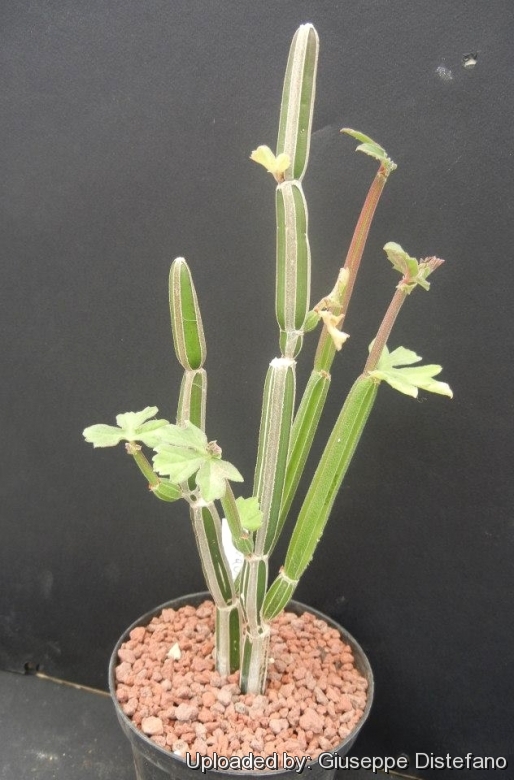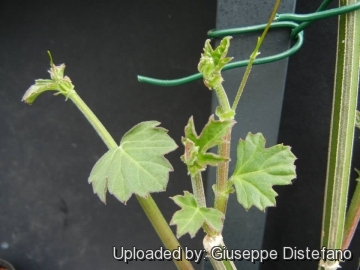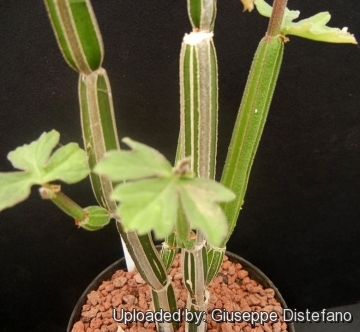




Your support is critical to our success.

Origin and Habitat: Tropical Africa (Etiopía, Kenia, Somalia and probably also in Tanzania)
Altitude: 0-450(-1500) metres above sea level.
Habitat and ecology: It grows mostly in soil pockets on limestone outcrops or coral in open riverine forests and grassland with scattered trees (habitats moist for entire year) together with Brachystegia spiciformis.
Synonyms:
- Cissus quinquangularis Chiov.
ENGLISH: Five-ribbed Cissus
RUSSIAN (Русский): Циссус пятиугольный
Description: Cissus quinquangularisSN|32090]]SN|26936]] (Five-ribbed Cissus) is a pretty succulent climbing plant with slender stems, 2 to several metres long, that is a part of the grape family. It is similar to Cissus quadrangularisSN|33662]]SN|33662]] and Cissus cactiformisSN|26936]]SN|32090]], but stems 5-angled and sometime consider conspecific with the latter.
Stems: Slender, fleshy, cactus shaped, 2,5-4 mm wide, grey-green, 5-angled, the angles Along each angle is a leathery edge grey to brown or purplish, horny, sharp. Older stems to 1,2 cm wide, more obtusely angled, glabrous.
Leaves: Green, toothed simple or trilobed about 2 to 5 cm wide that appear at the nodes. Each leaf has a tendril emerging from the opposite side of the node.
Spines: Rare and sharp along the edges, almost triangular.
Fruits (berries): Spherical red when ripe.
Bibliography: Major references and further lectures
1) Henk Beentje, Joy Adamson, Dhan Bhanderi “Kenya trees, shrubs, and lianas” National Museums of Kenya, 1994
2) E. Chiovenda "Flora Somala" 2: 142 1932

Cissus quinquangularis Photo by: Giuseppe Distefano

Cissus quinquangularis Photo by: Giuseppe Distefano
Cultivation and Propagation: Cissus quinquangularisSN|26936]]SN|26936]] is a good climbing succulent in frost free zones and also a great container plant for full sun to partial shade.
Growth rate: It will grow best when provided with warmer temperatures, long daylight hours, adequate moisture and a rich soil. Given these conditions, this species will grow rapidly, with the annual vines growing to 50 cm and possibly to as much as 2 metres.
Exposure: Full sun to filtered light.
Soil: Give the plant a well drained, airy, growing medium which mainly consists of non organic material such us clay, pumice, lava grit, and only a little peat or leaf-mould.
Watering: Water regularly from spring to autumn. Keep the drier and cooler in winter, to induce dormancy. But others suggest to water it moderately all year round as it tends to be an opportunistic plant that tend to grow in each time of the year whenever it has enough water in fair weather and rest when temperatures are too hot or too cool and may have several or sometimes no growth cycles in a year. No water should ever be allowed to stand around the roots. But it adapts to different growing conditions from extreme heat and drought, to high moisture as it has a low rot potential.
Fertilization: The plants should be fed regularly with a fertilizer suitable for succulent plants.
Hardiness: The optimal temperature is 16-30°C (USDA Zones: 10 -12 ).
Spring: When winter ends and they begin to grow again, they will require much water and soaking the pots will no longer put the plants at risk for rot. In the spring they will grow well in partial shade and leaving them out in the rain may provide them with the water they need.
Summer: In the summer months they will tolerate heavy rain, but will be just as happy if the season is dry. They will tolerate hot weather outdoors as long as they are kept in strongly filtered light and this will encourage them to flower. They also enjoy some fertiliser. Moving the plants as they are developing buds may cause them to spontaneously abort the flowers all together.
Autumn: In the fall keep them outdoors until the night time temperatures drop below the 10°C.
Winter: Winter care presents no problems at 10° C with plenty of light. In winter be sure to take extra precautions to keep them dry, because damp cool conditions when the plants are resting is an invitation to fungal infections, but - according to temperatures –some occasional lit watering may be useful.
Maintenance:In cultivation, these vines can be clipped to much shorter lengths to control rampant growth. This species do tend to get sort of leggy, which is particularly a problem if grown as a potted plant, and yearly pruning is often necessary to shape. Like quite small pots, repot in very later winter, early spring.
Garden uses: It is often grown in containers and trained to grow on trellises on verandahs, fences and in glasshouses.
Traditional uses: Cissus quinquangularisSN|26936]]SN|26936]] was used by the Maasai people of Kenya to relieve some of the symptoms of malaria.
Pest and diseases: Cissus are generally fairly easy to grow, especially if kept pest-free. They are susceptible to stem and root mealy bugs, and damage from these may well initiate fungal attack. Any time when there is a dead or dying stem in the pot it is important to remove it immediately and completely before other healthy stems can become ill too, isolate the healthy parts, dry them off, and re-root them in new compost.
Propagation: It do not need to be propagated from seed as it make easily roots at the contact to the soil. Most plants in cultivation have been propagated by this means alone. Take cuttings in late spring to summer, just take a cutting of the plant let it dry for 1 or 2 weeks and stuff it in the ground (preferably dry, loose, extremely well draining soil).
| Your Actions | |
|---|---|
| Back to Cissus index | |
| Back to Vitaceae index | |
 |
Back to Succulents Encyclopedia index |
Privacy stantement - Terms and conditions - How to cite - About us - Feedback - Donate



